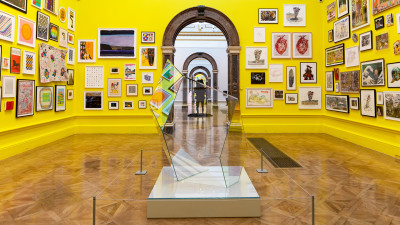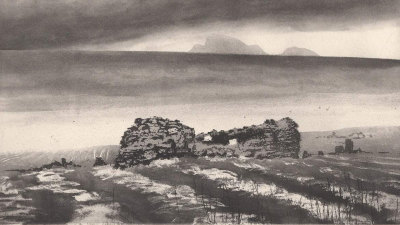Nine things to know about the Summer Exhibition
Nine things to know about the Summer Exhibition
By Louise Cohen
Published 4 June 2022
An invitation to artists everywhere, a story that goes back to Turner – and a top secret tea recipe. Here’s what you need to know about a weird and wonderful art tradition that’s over 250-years-old.
-
An earlier version of this article was published in June 2016.
1. It’s open to all artists
The RA was founded to champion the practice of art, with one of its promises an open invitation to the public to submit work for an annual show. It’s happened every year since 1769 – lending it plenty of weird traditions and legendary incidents (read on for an in-gallery showdown between Turner and Constable). Entrants have even included famous names; from Winston Churchill (who exhibited under a pseudonym) to more recently, comedians Joe Lycett and Harry Hill.
2. It’s curated by a committee of artists
Each year an artist co-ordinator is chosen to direct the show who then meet with a committee of Academicians to review thousands of entries and to discuss plans for the show, with artists each taking responsibility for different rooms.
Organising the Summer Exhibition is always a herculean task – but this was especially so during the pandemic. Some of our committee members were self-isolating or couldn’t travel to the UK due to the coronavirus pandemic, and instead had to hang their galleries over Zoom video calls!
3. The work is for sale
The Summer Exhibition has always been an opportunity for artists to sell their work. In today’s show, the artist remains the seller of the work and the RA takes a 30% commission. The proceeds go towards the RA Schools, where tuition is free for our post-graduates students each year. Many works are also available to buy online. Read our tips for buying your first pieces of original art.
-
4. Leading artists exhibit too
Alongside the selected entries, our Royal Academicians – the artists and architects elected to run the RA – can choose to put in up to six works each year, with other artists also commissioned to create work for the show. This is the reason that a first-time exhibitor can quite easily find their entry next to work by the likes of Grayson Perry or Tracey Emin.
5. The final choices are made in the gallery
After several rounds of judging, the committee make their final selections for inclusion inside the gallery, as they try out pieces on the wall during the eight-day hang. The exhibition is finalised on “Sanctioning Day” when the committee meets for the last time – after this, no changes can be made.
6 …and the committee drinks beef tea
One of the committee’s great privileges (we write this having never tasted it, of course) is the mysterious “beef tea” that they’re offered during the eight-day hang. The recipe remains secret.
-

Art handlers hanging the 2018 Summer Exhibition

Thomas Sandby RA (1723-1798), The Royal Academy annual exhibition of 1792, 1792.

The 163rd Summer Exhibition, 1931

The 166th Summer Exhibition, 1934: William Russell Flint being offered a cup of beef tea while at work arranging the hanging of oil paintings in one of the galleries, April 1934
-
7. Note the tradition of Varnishing Day
Historically, artists would visit the galleries to add final touches to their work in situ. Today, Varnishing Day remains a part of the Summer tradition, but it’s now mostly a day to celebrate the artists in the show – if a slightly weird one. Before visiting the show, the artists gather in the courtyard, form a procession down Piccadilly led by a steel band, then attend an artists’ blessing at St. James’s church. Watch a video of it taking place.
8. Things got political
Visitors to the Summer Exhibition will be aware that there is always a lot to see. But it’s more restrained than it once was; in the 18th century, pictures were hung frame-to-frame – and there was serious competition for the prime spots. History painting and portraits by the celebrated artists of the day sat just above eye level, with smaller pieces below and others by lesser-known artists “skied” above. Petulance of the below nature was not uncommon.
9. There was a Turner-Constable showdown
It was Varnishing Day in 1832. Constable was busy putting the final strokes on The Opening of Waterloo Bridge, when his great rival entered the room. Observing that his own calm seascape, Helvoetsluys, looked pale in comparison, Turner marched up to his painting and added a red buoy in the middle of the canvas. Constable was devastated. He said that Turner had been in and “fired a gun”. Mike Leigh imagined the incident in his 2014 film, Mr. Turner.







